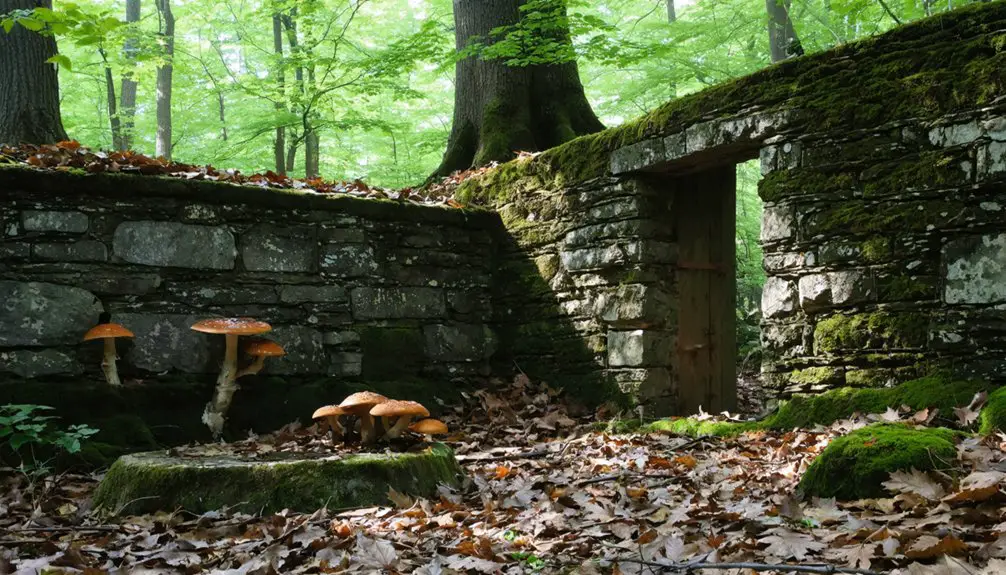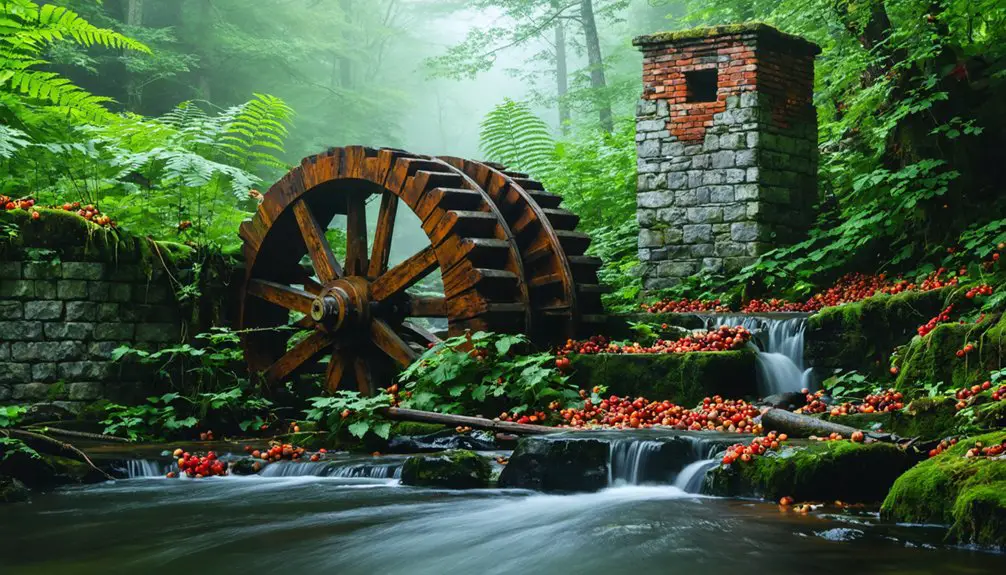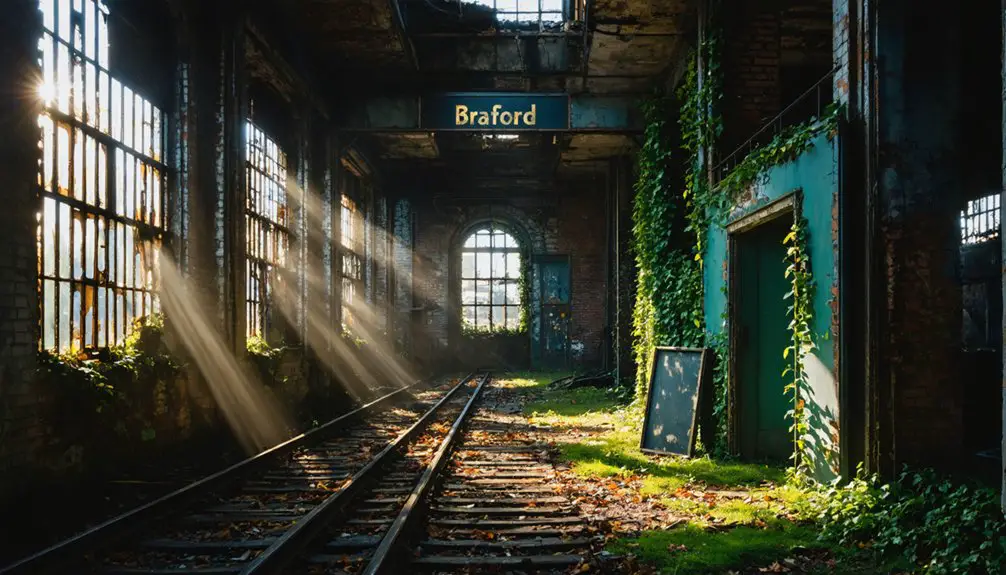You’ll discover Hanton City deep in Smithfield, Rhode Island’s woodlands, where three English yeoman families established a settlement after King Philip’s War in 1676. This remote colonial community thrived through farming, quarrying, and leather-working until its mysterious abandonment in the early 1800s. Today, you can find stone foundations, cellar holes, and a legendary well on land owned by Dow Chemical Company. The ruins hold centuries of stories, from political exile theories to supernatural tales.
Key Takeaways
- Hanton City is an abandoned colonial settlement in Smithfield, Rhode Island, established after King Philip’s War in 1676 by three English families.
- The ghost town’s remains include stone foundations, cellar holes, stone walls, and a supposedly haunted well hidden in dense forest.
- The settlement was abandoned in the early 1800s due to economic hardship, isolation, and the rise of mill technology.
- Local folklore earned it nicknames like “Lost City” and “Haunted City,” attracting paranormal enthusiasts to its mysterious ruins.
- The site is currently owned by Dow Chemical Company, making access restricted and complicating preservation efforts.
The First Settlers of Hanton City
When King Philip’s War ended in 1676, three English yeoman families – the Paines, Hantons, and Shippees – established what would become Hanton City in modern-day Smithfield, Rhode Island.
These settler backgrounds reveal humble origins, as yeoman status placed them near the bottom of colonial society’s hierarchy. You’ll find that they likely received their land as compensation for their service during King Philip’s War.
The family connections among these original settlers ran deep as they carved out a life of self-sufficiency in their isolated community. They sustained themselves through farming, stone quarrying, leather tanning, and boot making, relying heavily on bartering with one another. The settlement reached its peak in the 1730s, when the community flourished through these diverse economic activities.
The Hanton family’s presence endured the longest, with their last member living in the settlement until around 1900. Today, visitors can still see the remnants of stone walls that once marked the boundaries of this historic settlement.
Life in Colonial Rhode Island’s Remote Settlement
Life in colonial Hanton City embodied the challenges and triumphs typical of 17th-century Rhode Island‘s remote settlements. You’d have spent your days tending to apple orchards, onion fields, and flax crops, while also raising sheep and horses essential for survival.
In this close-knit community, you’d have relied on communal practices like barn-raisings and shared harvests to overcome the harsh New England winters. Relations with neighboring tribes were generally peaceful, as Roger Williams’ influence shaped early settler-native interactions in Rhode Island’s communities. The devastating King Philip’s War in 1675-76 brought destruction to many settlements in the region.
Your wooden-framed house would’ve served as a symbol of the settlement’s self-sufficiency, built from local timber and maintained through daily survival skills.
As a settler seeking religious freedom, you’d have participated in the democratic governance typical of Rhode Island colonies, while engaging in trade with nearby Narragansett tribes and maintaining connections to ports like Providence for essential supplies.
Archaeological Evidence and Remaining Structures
Silent stone foundations and cellar holes stand as the primary physical evidence to Hanton City’s colonial past.
You’ll find dilapidated stone walls marking property boundaries, an intact well, and the remains of a corn crib built on stone piers, all signifying the archaeological significance of this early New England farming community.
The Alfred Smith Cemetery provides essential genealogical links to the settlement’s founding families, while the surrounding vegetation both preserves and presents preservation challenges.
Large trees growing from cellar holes help date the town’s abandonment to the early 1800s.
While no standing wooden structures remain, the undisturbed nature of the site holds promise for future archaeological investigations.
You won’t find documented excavation reports of artifacts or material culture, suggesting there’s still much to discover beneath the overgrown landscape.
Local residents once worked in the stone quarry that supplied building materials for structures in Providence.
The land is now controlled by Dow Chemical Company, making access and preservation efforts complicated.
The Mystery Behind the Abandonment
Despite extensive research and archaeological evidence, the true reason behind Hanton City’s abandonment remains one of Rhode Island’s most intriguing historical puzzles.
You’ll find several competing abandonment theories, with political exile being a prominent explanation. Historical records show Loyalists were forced from Newport to nearby areas in 1776, suggesting the settlement’s residents may have faced similar displacement during the American Revolution.
Another compelling theory points to the settlement’s extreme isolation from Smithfield’s center, which likely created unsustainable living conditions.
By examining the 1937 Providence Journal’s description of century-old trees growing through former house sites, you can date the abandonment to the early 1800s.
Whether driven by political persecution, disease quarantine, or simple economic hardship, the ghost town’s desertion reflects the harsh realities of colonial New England life.
Legends and Local Folklore
Through the passage of time, Hanton City’s mysterious ruins have spawned a rich tapestry of local folklore, earning nicknames like “Lost City” and “Haunted City” since the 1880s.
While early residents initially dismissed supernatural claims with amused contempt, decades of isolation and decay have transformed the settlement into a magnet for paranormal enthusiasts.
However, historical records show that the village’s decline was primarily due to economic mill development that left local craftsmen unable to compete in the marketplace.
You’ll find the most compelling elements of Hanton City’s ghostly reputation centered around:
- The ancient well, where visitors report frequent ghost sightings and unexplained phenomena
- Weathered cellar holes and stone foundations, which inspire eerie experiences among explorers
- The nearby Alfred Smith Cemetery, which adds a layer of mystery to the abandoned settlement
The site’s legends have evolved from simple local tales into a complex web of theories, including stories of exiled Loyalists, runaway slaves, and mysterious disappearances.
The Alfred Smith Cemetery
Nestled along the Hanton City Trail in Smithfield, Rhode Island, the Alfred Smith Cemetery stands as a poignant reminder of the area’s colonial heritage.
You’ll find three legible gravestones marking the final resting places of Alfred Smith (1770-1828), his wife Eliza (1785-1840), and their son Emor (d.1826).
The cemetery’s historical significance lies in its connection to Hanton City’s early settlers, who were primarily craftsmen and artisans living quietly in this now-vanished community.
While cemetery preservation faces challenges from encroaching vegetation and potential development, the site remains an invaluable landmark. The cemetery’s deteriorating condition is evident through its heavily vandalized state and missing entrance gate.
Now owned by Dow Chemical Company, this small burial ground continues to serve as one of the few tangible links to Hanton City’s past, cataloged as Historical Cemetery Smithfield #62.
Economic Factors Leading to Decline
While Hanton City initially sustained itself through colonial-era farming practices, several economic factors converged to seal its fate as a ghost town by 1900. The settlement’s extreme isolation from Smithfield created insurmountable barriers to growth and prosperity, leading to economic stagnation that persisted throughout its existence.
You’ll find three critical factors that drove Hanton City’s decline:
- Limited agricultural capabilities, with only subsistence farming possible due to poor infrastructure and a failing irrigation dam.
- Complete lack of industrial development during New England’s broader economic transformation.
- Demographic decline that accelerated as families couldn’t sustain themselves, culminating with the last Hanton residents’ deaths around 1900.
These challenges, combined with possible political tensions from the Revolutionary period, created a downward spiral from which the settlement couldn’t recover.
Exploring the Ghost Town Today
Today’s visitors to Hanton City encounter a haunting tableau of New England’s colonial past, where stone foundations and mysteriously intact wells peek through centuries of forest reclamation.
If you’re planning some urban exploration, you’ll find the site deeply hidden in Smithfield’s dense woods, accessible only by foot through open gates leading to a clearing.
You’ll discover about a dozen colonial-era homestead foundations, with stone cellar steps still visible beneath ancient trees.
The ghostly encounters begin at the legendary well, said to be haunted, which has survived intact despite the centuries.
While trails exist, they’re now overgrown and challenging to navigate. Your best bet for exploring is during seasons with minimal foliage, when you can better spot the stone walls, burial sites, and other remnants of this lost settlement.
The land where these historic remnants sit is now owned by Dow Chemical Company, making access to the site limited.
Signs of the past include scattered pieces of multicolored glass and bottles that hint at the daily lives of former residents.
Historical Documentation and Research
The historical record of Hanton City begins to emerge in the 1730s, though its documentation remains fragmented across various sources.
Historical diaries from residents like Thomas Vernon and Thomas Hanton offer firsthand insights into the settlement’s social dynamics and eventual decline.
You’ll find the documented history of this ghost town revealed through:
- Family diaries detailing the community’s poverty and gradual dispersion
- An 1880s Providence Journal article that first coined the term “Haunted City”
- 20th-century newspaper articles that helped establish the timeline of abandonment
While local folklore has woven tales of disease and Loyalist exile, these haven’t been substantiated by primary sources.
Instead, historical documentation points to economic hardship and the rise of mill technology as key factors in the settlement’s demise.
Frequently Asked Questions
Were Any Valuable Artifacts Ever Discovered at the Hanton City Site?
Despite 100+ years of historical interest, you won’t find any valuable artifact discoveries at this site – just stone foundations, walls, cellar holes, and a well representing historical significance.
What Happened to the Descendents of the Original Hanton City Families?
You’ll find descendant stories scattered across surrounding towns, as families gradually dispersed by the early 1800s. Their family legacies live on through descendants who integrated into other New England communities.
Did Native Americans Interact With the Hanton City Settlers?
You’ll find cultural exchanges between Native Americans and settlers were likely common, though historical relationships aren’t well-documented. Evidence suggests peaceful coexistence in the area following King Philip’s War.
How Large Was Hanton City’s Population During Its Peak?
While records from the 1730s peak show only dozens to possibly low hundreds of residents, you’ll find it fascinating that this small community’s demographics shifted dramatically during the population decline of early industrialization.
Were Any Official Maps or Land Surveys Made of Hanton City?
You won’t find detailed original surveys, though state maps from the 1850s show basic location. Land ownership records and historical documentation are sparse, with modern surveys only capturing remaining stone features.
References
- https://en.wikipedia.org/wiki/Hanton_City
- https://www.youtube.com/watch?v=kpy7zlXYrAU
- https://smithapplebyhouse.org/arethereghosts/
- https://vitabrevis.americanancestors.org/2017/01/no-notorious-scandals
- https://weird-island.simplecast.com/episodes/57-ghost-town-hanton-city-ky53imy0
- https://kids.kiddle.co/Hanton_City
- https://en.wikipedia.org/wiki/History_of_Rhode_Island
- https://www.britannica.com/place/Rhode-Island-state/History
- https://www.rihs.org/files/MiddleSchoolGuide.pdf
- https://en.wikipedia.org/wiki/Colony_of_Rhode_Island_and_Providence_Plantations



